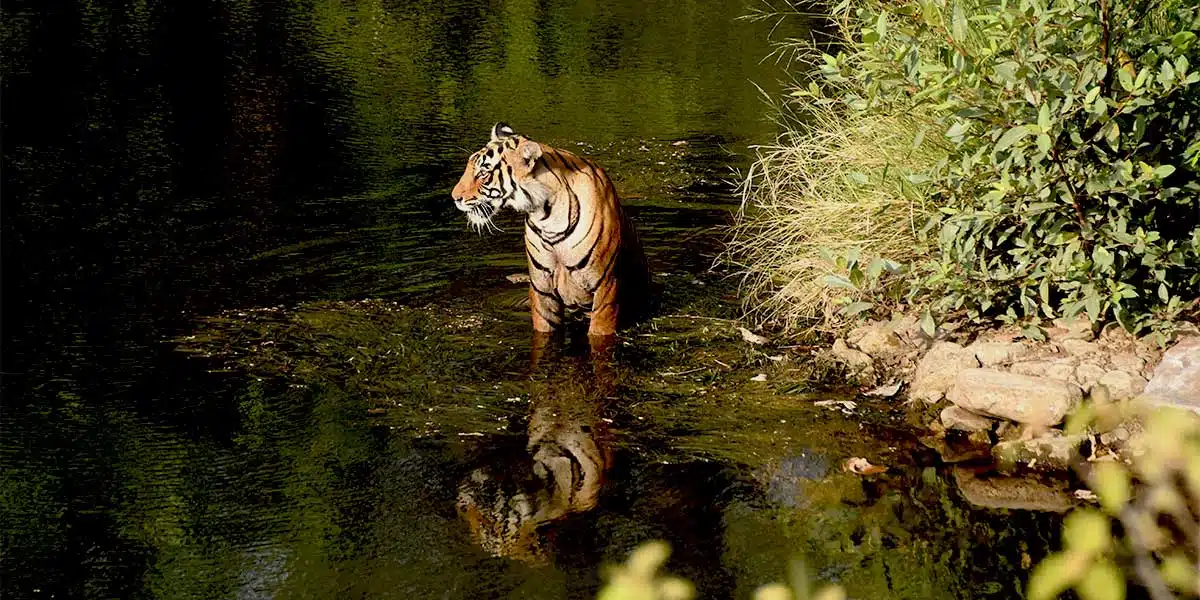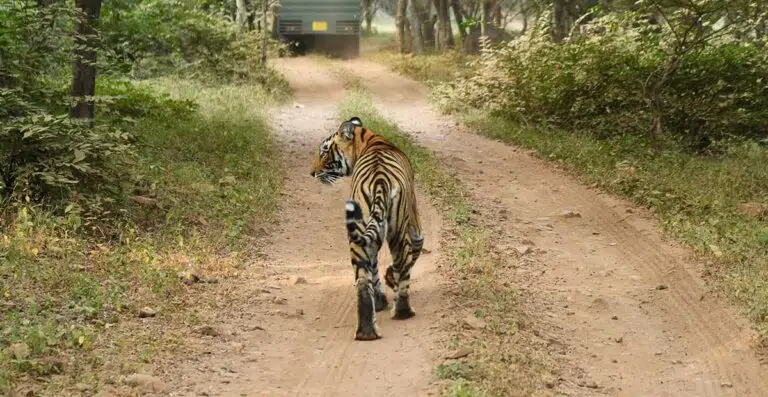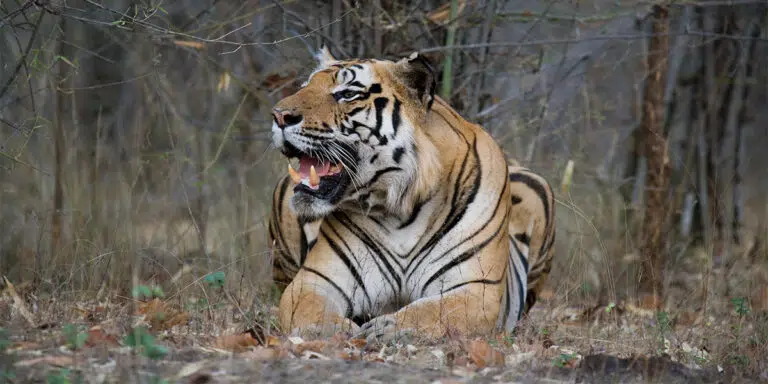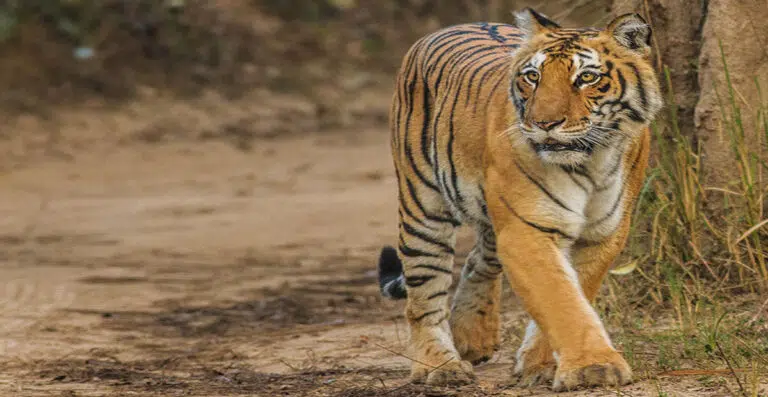History of the Tigers in India
Unveiling the Majesty of the Royal Bengal
The magnificent and elusive tiger, an apex predator and an emblem of strength, has been an integral part of India’s rich wildlife heritage for centuries. The history of tigers in India is as fascinating as the creature itself. From royal hunts to conservation efforts, the story of these majestic felines unfolds a captivating narrative that spans cultures, generations, and landscapes.
Tigers are magnificent creatures; their distinctive stripe patterns and powerful roars are symbols of strength and power embodying all the splendours of Mother Nature. So is the History of the Tiger in India. Its size and strength belie its grace and stealth. It hunts with cunningness and extreme precision, swooping fast through the forest on the dot to catch its prey.
निर्वनो वध्यते व्याघ्रो निर्व्याघ्रं छिद्यते वनम्। तस्माद्व्याघ्रो वनं रक्षेद्वयं व्याघ्रं च पालयेत् ॥
The Regal Era: Tigers in Indian Royalty
Tigers in Royal Courts
During the regal era, tigers held a special place in Indian royalty. Kings and nobles indulged in the grand tradition of tiger hunting, showcasing their bravery and prowess. These hunts were elaborate affairs, often attended by the elite, where tigers were pursued on horseback or elephant-back.
How the Tiger gets its name?
Tiger is a word derived – Persian and Urdu
The term “Tiger” has Persian or Iranian ancestry and means “arrow” in its original form. In India, the term “arrow” is denoted by the Urdu word “Teer.”
Table of Contents
History of Tiger with Relevance to Hindu Mythology
Hindu Mythology has its relevance of a tiger as the invincible Goddess Durga, the guardian of good against evil, is seen atop a tiger symbolising “shakti” or “vigour” that of a tiger. The magnificent illustrations of the goddess riding a tiger can be seen in numerous houses in India. Goddess Durga is the epitome of strength, and the tiger is the primary emblem of her might that she employs to control the beast’s force and uphold morality.
History of the Tiger in India from the Eastern parts
‘Bonbibi’ or ‘Bandevi’, in its literal sense, refers to the ‘lady of the forest’, a guardian spirit of the Sundarbans forests who is venerated by both the Hindu and the Muslim natives. The world’s largest mangrove forest, the Sundarbans is home to the Bengali people who rely on the forest’s output for their living and is spread across Southern Bangladesh and West Bengal in eastern India. Every time people venture into the marshy mangroves to fish or gather firewood, survival is at risk. The gruesome tales of man-eating tigers are sufficient to dissuade someone who has the means to live a life outside of the necessities of the forest.
History of the Tiger in India from the Central Parts
The Baiga tribe regards themselves as the descendants of the Tiger, and the survival of the tigers in Central India has been possible because of the innumerable sacrifices made by the people of this tribe who consented to leave their long-established homes in the various Tiger Reserves at the behest of the Indian Government. And, even though many younger generations would not have seen the Tiger, there is friction since animals are frequently killed and there are infrequent human attacks, the incredible amount of patience the natives and neighbours show is applaudable.
The king was a true tiger hunter, and he had the scars to prove it.
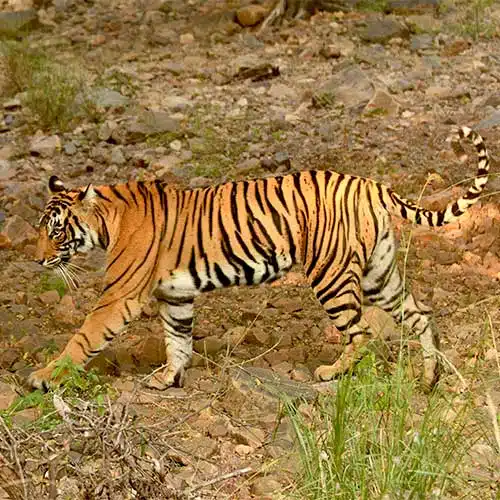
Tigers as Symbols of Power
Tigers were not merely hunted for sport but also revered as symbols of power and royalty. The majestic beast embodied strength, courage, and authority, attributes sought after by kings. Tiger motifs adorned palaces, thrones, and coats of arms, signifying the ruler’s might and dominion.
A Battle for Survival: Tigers and Conservation
Decline in Tiger Population
Over time, human encroachment, habitat loss, and rampant poaching took a toll on the tiger population in India. As the 20th century dawned, tigers faced a grave threat of extinction. Their numbers dwindled alarmingly, pushing the nation towards a critical point in tiger conservation.
History of Tiger Hunting in India
Shikar, which refers to sport-hunting, was a popular phrase in India and was often used colloquially in English. Its origins date back to the middle of the 16th century, during the reign of the Mughal Emperor Akbar. He started the Mughal emperors’ custom of royal hunting, or shikar, which continued until the dynasty collapsed in 1857. And, the son of Emperor Akbar, Jahangir, enumerated over 28,500 different types of animals that he had hunted throughout his lifetime.
In the tenth century AD, the Rajput Kings – the elegantly attired warrior royals were well-known for their prowess on the hunt. Presenting an excellent variety of food with a long history of hunting animals like partridge, rabbit, antelope, and deer in India and the rest of the globe.
The Maharajas of Rewa in Central India thought it was fortunate to kill 109 tigers before battle or Ascension.
When the British arrived in India in 1757, this ritual persisted. The British Raj enjoyed staging grandiose large game hunts as a way to flaunt their wealth, malevolence, and strength.
In the 1850s, 300 tigers were killed by Colonel Geoffrey Nightingale, the commander of the 3rd Cavalry in Hyderabad.
Following the ascension, King George V and his companions embarked on a joyous hunting expedition to Nepal. In just ten days, they hunted 39 Royal Bengal Tigers, 18 Greater One-Horned Rhinos, and 1 Sloth Bear in Chitwan National Park.
In the 1920s, Umed Singh II, Maharaja of Kota, Rajasthan engaged a modified flaming-red Roll Royce Phantom – mounted with a Machine Gun and a Lantaka Cannon – a mean machine to obliterate any animal in sight.
Umed Singh II, the Maharaja of Kota, Rajasthan in the 1920s, used a customised flaming-red Rolls-Royce Phantom fitted with a machine gun and a Lantaka Cannon to eradicate any animal that came into view.
The Indian government forbade hunting in 1971 after thousands of tigers were killed in elaborate hunts by Indian and British royalty.
With no laws prohibiting tiger hunting, there was a killing spree in 1947 following the British departure from India. As a result, anyone in India might try their hand at tiger hunting. Even hunters from all over the world were invited to do what they pleased – think of it like modern-day Tiger Tourism in India but without firearms. The Royal Bengal Tigers nearly went extinct due to open warfare.
Eminent wildlife biologist George Schaller was informed with pride by the Maharaja of Surguja that he had hunted 1150 tigers by 1965. The Indian Trophy Hunting Era virtually eliminated the biggest tigers from the gene pool. Until the Indian government forbade hunting in 1971 after thousands of tigers were killed in elaborate hunts by Indian and British royalty.
Project Tiger: A Ray of Hope
In 1973, recognizing the urgency of conserving tigers, the Government of India launched Project Tiger. This pioneering initiative aimed to protect the tiger’s habitat, combat poaching, and ensure the survival of this magnificent species. Today, Project Tiger stands as a testament to India’s commitment to wildlife conservation.
Project Tiger was a turning point in the history of tigers in India, marking a shift from hunting to preservation.

Wildlife Protection Act of India 1971 & Project Tiger 1973
At the onset of the 19th century, the approximate population of Tigers was between 40000–50000. Since then, the number of tigers in India has been severely reduced due to poaching, hunting, and habitat degradation. The tiger population in India has historically reached an all-time low as a result of the animals being treated like vermin and the desire for parts of the animal for conventional medicine and boasting India’s independence from British rule.
Mr. Kailash Sankhla, an eminent conservationist and zoologist following a period of persistent influencing and data gathering around 1970 made the Indian government aware of the necessity of safeguarding the tigers from killing and the significance of preserving them as a keystone species. With an unwavering dedication to protecting wildlife, Indian Prime Minister, Mrs. Indira Gandhi finally oversaw the drafting of the Wildlife Protection Act of 1972, which restricted the killing of all wildlife species and provided them with legal protection in India.
Project Tiger was first implemented in 1973, following its inception Jim Corbett Tiger Reserve in Uttarakhand became its first Tiger Reserve. A total of 50 Tiger Reserves have been formed in India, with an additional 08 Tiger Reserves that were delineated with around 9115 sq km of protected forest. This figure currently stands at over 71,000 sq km of protected land.
50 years of Project Tiger: Reviving the roar of the big cats
National Parks and Tiger Reserves
To secure the tiger’s future, numerous national parks and tiger reserves were established across the country. These protected areas provide a safe haven for tigers and other wildlife, ensuring their survival for future generations. Prominent tiger reserves include Bandipur National Park, Corbett Tiger Reserve, and Kanha Tiger Reserve.
Frequently Asked Questions
India is home to the largest population of tigers in the world. According to the latest census conducted in 2022, the tiger population in India stands at approximately 3,000 individuals.
The largest tiger reserve in India is the Nagarjunsagar-Srisailam Tiger Reserve located in the states of Andhra Pradesh and Telangana. It spans an impressive area of over 3,500 square kilometers.
Yes, the festival of ‘Mowgli Utsav’ in Madhya Pradesh celebrates the tiger’s presence in
the famous Pench National Park. It aims to raise awareness about tiger conservation
through various cultural programs and activities.
Yes, tigers are classified as an endangered species in India. Despite conservation
efforts, they continue to face threats such as habitat loss and poaching.
The Royal Bengal Tiger (Panthera tigris tigris) is the national animal of both India and
Bangladesh. It symbolizes strength, resilience, and the rich biodiversity of the Indian
subcontinent.
You can contribute to tiger conservation in India by supporting reputable wildlife
organizations, spreading awareness about the importance of conservation, and
practicing responsible tourism when visiting tiger reserves.
Conclusion
- The history of tigers in India is a tale of admiration, awe, and conservation.
- From their exalted status in royal courts to their endangered existence, tigers have captured the imagination of people across generations.
- India’s commitment to tiger conservation through initiatives like Project Tiger and the establishment of protected areas gives hope for the survival and thriving future of these magnificent creatures.
- Preserving the history of tigers in India is not only a matter of pride but also a collective responsibility to safeguard the biodiversity and natural heritage of the nation.
- Together, we can ensure that the royal roar of the tiger continues to resonate through the forests of India for generations to come.
